Behind the mask
Basic or beautiful, face masks are here to stay - make them a vehicle for safety and self-expression.
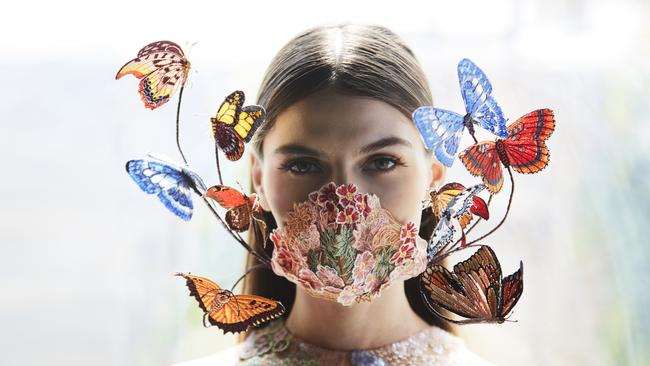
To mask, or not to mask? For those not on the frontline of the COVID-19 pandemic, this seems to have been the question since it all began. Do they work? Do they not? Are they medical grade? Does it matter?
It has taken months for health professionals globally to say, well, yes, even a simple cloth mask does help lower transmission rates, by as much as 80 per cent.
Still, in recent months mask wearers have been a rare sighting on the streets of Australia.
But all that’s about to change. From 11.59pm on Wednesday, residents of Victoria’s lockdown regions are required to wear a face mask when they leave the house.
Victorian Premier Daniel Andrews and his team, including Chief Health Officer Brett Sutton, have been leading by example at conferences.
Even US President Donald Trump, who has long ignored the benefits of protective face wear — despite medical advice and with the US death rate from COVID-19 climbing to more than 140,000 — finally sported one recently.
They have become a political flashpoint in the US, especially, with some claiming they are an infringement on their freedoms.
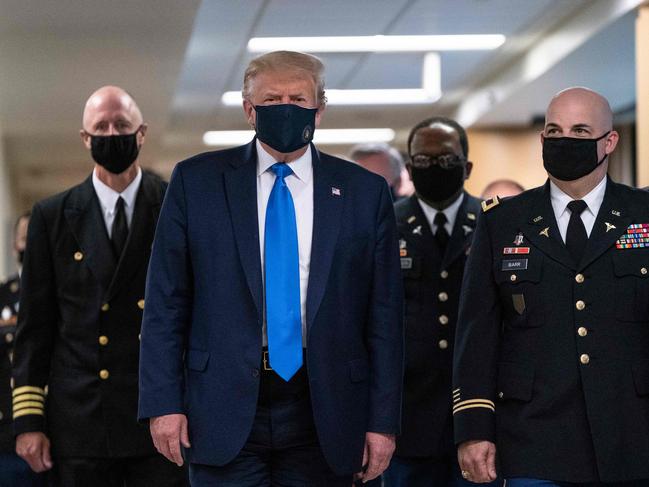
But masks aren’t a new thing.
Laini Burton, a senior lecturer at the Queensland College of Art at Griffith University, has a particular interest in masks as fashion items.
Last month she did an online presentation for the conference The New Normal: Sartorial and Body Practices of the Quarantine Era, hosted by Fashion Theory Russia and The New Literary Observer publishing house.
In this, she pointed out precedents for the use of masks as a pandemic shield, such as during the 16th-century plague and the Spanish flu of the early 20th century.
She also discussed their history as a fashion and cultural item.
“(Masks have) a deep history across cultures,” Burton tells The Australian, adding that her following examples do not include the use of masks in First Nations cultures.
“Masks have been around in association with fashion for over 400 years, and then through theatre for even longer. Here they are again. This isn’t a new thing, it’s a resurgence.”
She says that historically they have been seen as an instrument for celebration and liberation – covering the face allows the wearer to take on another personality or act with anonymity.

Political point-makers aside, when people push back today against wearing face masks in the face of a global pandemic, “it goes to prove how we so value being seen”, says Burton.
“The visibility of our face in the West has become highly significant, a form of currency. To cover it has been seen as an affront to Western society in terms of how we value individualism. The idea that you are somehow compromising your identity or hiding something by wearing a COVID-19 mask is an absurd notion.”
Transition phase
As with many new fashion trends, timing is everything. While there are early adopters, others can lag behind in embracing the new. Add to that a pandemic and it’s a potent combination for brands.
Perth designer Natalie Rolt discovered this the hard way. When she started selling cotton face masks online at the end of March, social media and online news outlets swiftly rounded on her for, essentially, trying to profit from the pandemic.
This was at a time when outrage was building around the lack of personal protective equipment for frontline health workers. But the pile-on was plentiful. (Rolt declined to comment for this story.)
Mere months later, mass-market brands including Bonds, Everlane and Asos all tout their own styles and colours.
Some luxury brands, too, such as Proenza Schouler, Fendi and Akris, have also jumped on board.
A handful were offering face masks as pollution filters before the COVID-19 pandemic began; while not commonplace on catwalks, they have cropped up in recent years, usually for those brands that want to make a stance on environmental issues.
Several of the major luxury houses, including Louis Vuitton, Gucci, Chanel and Ralph Lauren, began manufacturing PPE for frontline workers at the start of the pandemic, not for their own profit and not for customers.
For those brands that are making face masks for customers, some have decided to donate part of the proceeds to a charity or to donate masks to those in need in addition to those that they sell.
Sydney label Ginger & Smart began selling face masks at the beginning of May, using fabric scraps from its own production, and donating part of the proceeds to the Sydney Women’s Fund for vulnerable women.
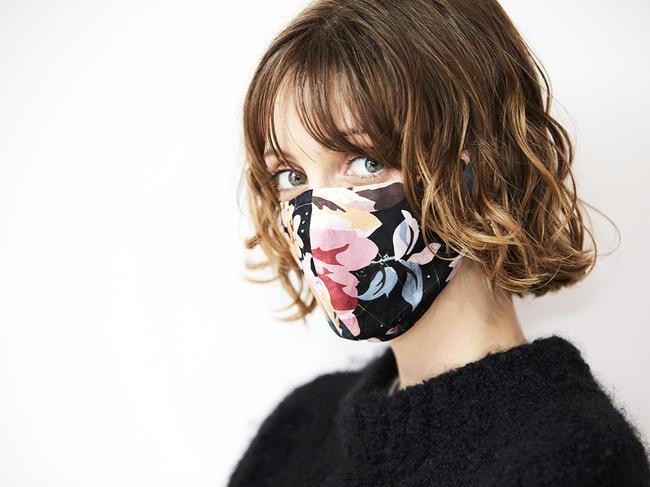
“They were really unsure times to know which way to jump,” says co-founder Alexandra Smart. She says that for the first run, the brand saw it as a way of connecting with its VIP customers during uncertain times. “They were really well received. So we started to manufacture another production run of them and did some in black, and they sold really well as well.”
The brand is about to go into its third production run. “I think we weren’t sure if masks were going to be here for the long haul, but they are. I do think we made a good early decision and they were well received, so we were grateful.”
Lead by example
In situations where there is no governmental directive on wearing masks, and fear of infection isn’t enough, how do you get people to wear masks? Ultimately, it has to be seen as more “normal” and people may respond to seeing those they respect or admire wearing them.
Several celebrities have worn masks since the pandemic began, and Burton believes that they could start to shift perception among the public.

“Celebrity culture and fashion design have significant sway in society, if not more than politics,” says Burton. “Both have a responsibility to lead by example.
“It was quite telling when you saw Trump’s administration come out with the masks. The fact that it has been politicised as anti-freedom is absurd. If people in positions of leadership are willing to lead by example we have a better chance of it sticking around.”
In fashion terms, will they take off as a must-have accessory?
Paris-based Australian designer Martin Grant believes so. He designed a mask at the beginning of the pandemic, and made them for friends and family but decided not to put them into production.
Still, with Paris being so badly hit by the pandemic, he says they are “quite commonplace”, with about half of people in the streets wearing them. He adds that, as of this week, they are obligatory in public or enclosed spaces.
“Governments have been very slow to enforce them, but as it seems we are in for the long haul I think they will become a genuine fashion accessory,” he tells The Australian.

Indian designer Rahul Mishra agrees, adding that the fashion world can help to promote the use of face masks more broadly. He created a series of exquisite embroidered designs for his recent couture collection, shown in video format during Paris Haute Couture Week. “Masks played an integral role in the visualisation of this collection,” Mishra told The Australian, adding that they were not made to be sold.
Where the wearing of masks is mandatory, “the fashion industry can assist in making them seem less like a reminder of those difficulties that we’re facing and help lift the sentiment”, he says.
“(The World Health Organisation) recommends that the right kinds of masks are the easiest and most effective preventive measure in fighting with the virus. Following that lead, allowing people some visual or perhaps functional variation may allow them to accept it easily.”
Express yourself
While the basic surgical masks are the first experience for many wearers, the possibilities for self-expression are endless if you choose to embrace them as a fashion item.
“(For) fashion masks to become mainstream, they will have to be depoliticised and normalised — then expressive possibilities will be embraced,” says Burton. “Fashion should be fun. I think there’s already amazing examples of playfulness being witnessed.”
One of those is an exhibition at the Artisan gallery in Brisbane, called AboutFace.
The craft gallery put out a call on social media for craftspeople to make face masks as a creative response to the pandemic; it received 104 submissions from all over the world. While most are conceptual pieces, curator Cassandra Lehman says many of them are “very fashionable and functional”. The work of 68 local artists is currently on show in the gallery window, and the full exhibition can be seen online at aboutfaceartisan.org.
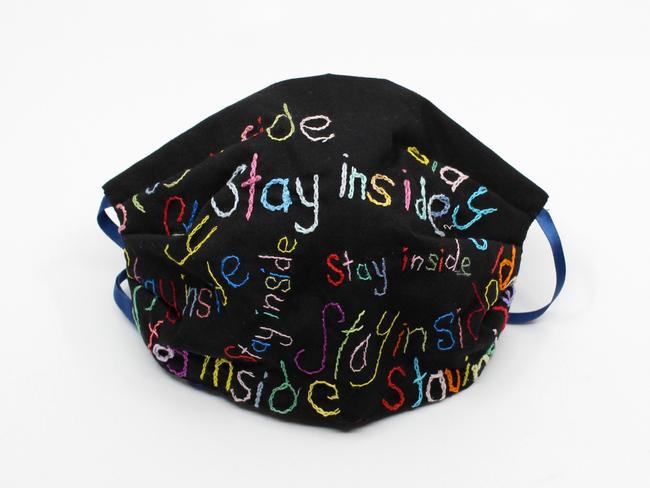
“There’s a lot of self expression in there,” says Lehman. “A lot of wit and humour and warmth and environmental concerns and political concerns.”
Beyond the exhibition, Lehman says that she has seen masks that re-create people’s faces, and “a number of people have put smiles on their masks”. She adds that online marketplace Etsy “is riddled with really funky face masks”.
Melbourne author of Modern Mending, Erin Lewis-Fitzgerald, has been perfecting face masks at home, following a deep dive into the various patterns on offer online. Her pick: the Iris Luckhaus Hybrid Mask (irisluckhaus.de), a variation on the common pleated styles.
She agrees that seeing stylish variations online will help normalise their wearing, and she says she was particularly pleased to see Nick Cave wearing a black silk mask made by his wife, designer Susie Bick.
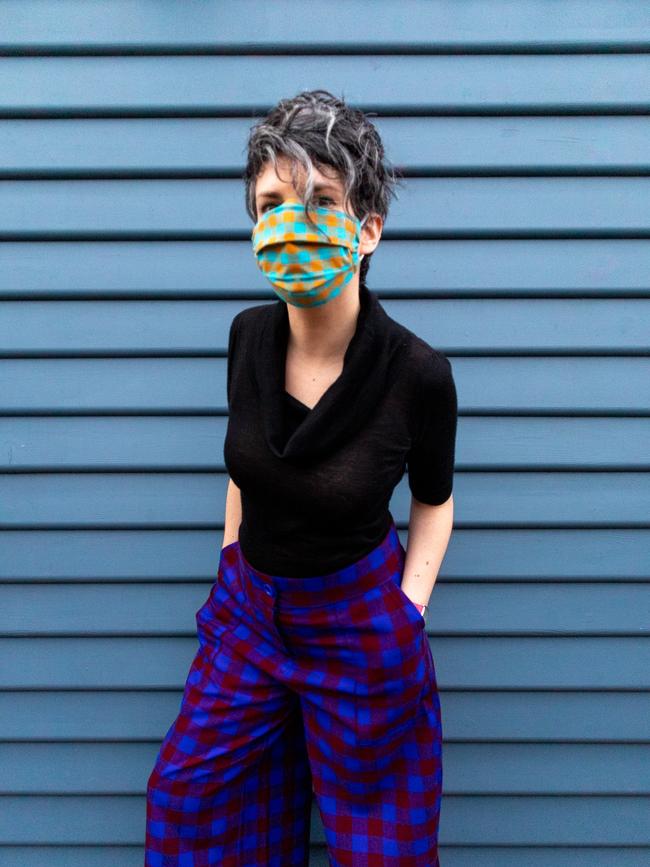
“I would love to have seen Instagram stories of people wearing awesome outfits and masks,” says Lewis-Fitzgerald. “I care a lot about style and colour and self expression, so I want to see examples of other people doing it. I know we can do it in a way that isn’t boring or sad, which is how I feel most of the time right now. Let’s give people a little bit of joy.”
To that end, she and friend Jenna Flood came up with the hashtag #themaskedoutfit to start the ball rolling on Instagram, and they are asking everyone to post their favourite looks.
Sutton has outlined what to look for in a cloth mask, recommending those made of “three layers of a mix of breathable fabrics”, and there are instructions on making your own (see dhhs.vic.gov.au). Suitable fabrics include tightly woven cotton and silk, even cotton from old pillowslips or T-shirts are readily available options.
The sock mask that has gone viral online is a simple option, although this has only one layer of fabric. Using scarfs as masks is not always recommended as the fabrics are often a looser weave.
Grant says that in Paris “people are getting creative and customising” their masks; he sounds mildly scarred by one he saw made from an old bra.
“If we’re all going to need to wear them, it’s great to be able to be playful with that and self-expressive,” adds Smart. “Serious as the situation is, accessories are a way to self-express, so why not?”

She is all for people matching their face mask to their outfit, and customising to their own taste. “The more people play around with what we do the better to make it their own.”
Mishra agrees. “As the masks primarily conceal a human’s most familiar medium of communication — their face — they become increasingly difficult to adapt to,” he says.
“It is important that they represent some emotion, mood or a statement that the wearer is able to relate with. This could be an individual expression or just in co-ordination with one’s outfit. We will only be able to use it with heart when it doesn’t feel like an imposition.”

To join the conversation, please log in. Don't have an account? Register
Join the conversation, you are commenting as Logout